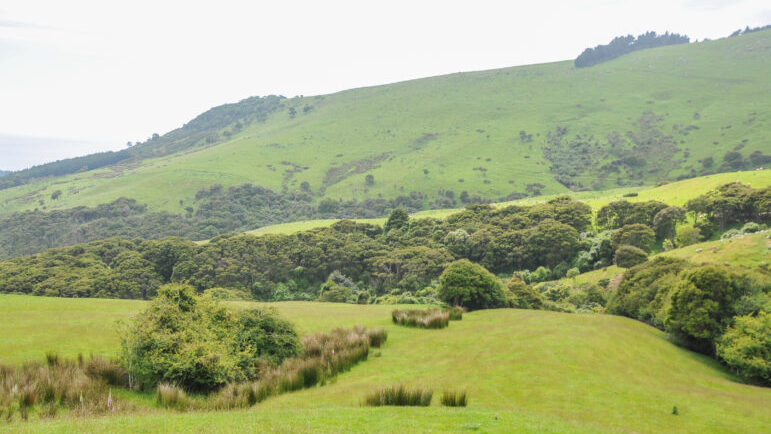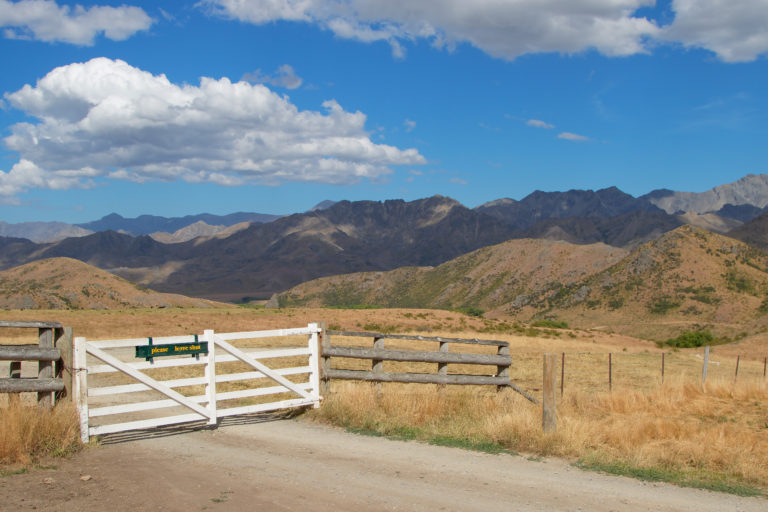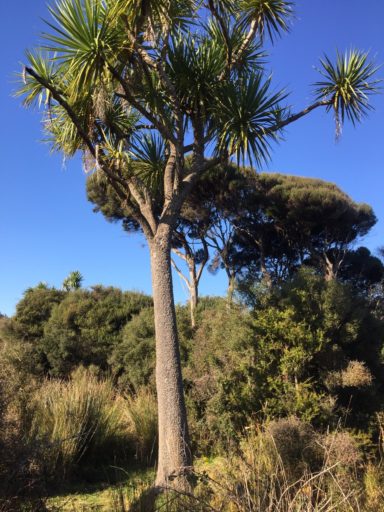Wetland areas and covenanted bush blocks on farms have a clear ecological value, but do they have an economic value as well? The answer is yes. But that leads to another question. How can you assess the economic value of an area of wetland or remnant forest that isn’t producing saleable crops or providing grazing for livestock?

Researchers Clint Cameron, Joanna McQueen-Watton and William Shaw of Wildland Consultants, Rotorua, assessed the economic valuation of ‘ecosystem services’ provided by 199,388 hectares of Pāmu Landcorp farmland to test out the process, assess the outcomes and demonstrate how it’s done. They’re hoping to encourage a wider uptake of the concept by local landowners and land managers and their report is published in full in the New Zealand Journal of Ecology.
First of all – what are ecosystem services? Some examples of potential ecosystem services give the general idea:
“Ecosystem services are defined as the benefits people obtain from ecosystems. Such benefits can be quantified and valued, including through methods which monetarise services. The fundamental importance of ecosystem services for human wellbeing is now a well-established concept, and ecosystem services are becoming increasingly integrated into decision-making processes.”

Ecosystem services are typically classified under five broad categories for valuation: supporting, regulating, provisioning, cultural, and passive. The value of exotic forest is easily quantified by the market value of the timber produced. It fits into the ‘provisioning’ category of ecosystem services.
We don’t, however, value our native forests by cutting them down for income. Instead they have a recreational value. Another ecosystem service provided by indigenous forests is their contribution to climate regulation and so on. Similarly wetlands provide value through regulating nutrient levels and preventing groundwater nitrogen from reaching toxic levels.
“To encourage wider uptake of the concept, there is a need to value and assess the provision of ecosystem services at scales relevant to local landowners and land managers in New Zealand. The current study was initiated by Pāmu Landcorp Farming and addresses this issue by assessing the economic value provided by ecosystem services across 126 of the Pāmu Landcorp farm units.”
The properties assessed, included ‘productive’ operational units (e.g. pastoral, horticultural, and exotic forestry land) and ‘non-productive’ areas (e.g. indigenous scrub, forest, and wetlands, including land retired from production). According to the researchers, both categories provide an array of important ecosystem services which have not been systematically valued to date.
So why do ecosystem services matter?
“The New Zealand Government has recently adopted the Living Standards Framework to help guide decision making through assessing impacts on intergenerational societal wellbeing. It marks a shift away from purely economic metrics such as Gross Domestic Product (GDP) as the sole indicator of progress, and incorporates the impacts that decisions have on the provision of ecosystem services (or natural capital) as one of the four pillars underpinning the framework.”
“Additionally, momentum is growing to adopt more holistic measures of wellbeing such as the Genuine Progress Indicator as a means to capture the costs and benefits associated with economic activity, such as the loss of soil ecosystem services or infilling of estuaries and harbours through sedimentation which are not tracked by GDP. However, one important remaining challenge is to distil ecosystem services valuations to local and regional scales to ensure relevance and encourage application of the concept in practice.”
Findings are intended to provide guidance to assist with farm management and decision-making. Results could, for example, help landowners and farmers in providing an economic justification for the retirement of productive or marginally productive land.
“Results also provide incentives to capitalise on emerging domestic and international markets such as the development of payment for ecosystems service (PES) schemes, e.g. forest carbon projects.”
For the most part, the researchers used land areas for each standard ecosystem as of 2012 reported in the most current version of the New Zealand Land Cover Database (LCDB V4.1 2015).
“TEV (total economic value) is then divided by land area (hectares) for each ecosystem to provide a valuation of each standard ecosystem per hectare per year.”
One significant PAMU property was excluded from the study.
“Molesworth Station, the country’s largest farm at 152,966 hectares, was excluded from this analysis. Inclusion of Molesworth Station would have effectively almost doubled the area of farmed land (70,049 hectares of productive land or 44.3% of total productive area across all of Pāmu Landcorp lands) yet the station carries less than 1% of overall stock. To put this in perspective, the next largest Pāmu Landcorp farm is Waipori Station at 12,556 hectares and including Molesworth Station would have disproportionately skewed the results. The remaining 126 Pāmu Landcorp farms can be considered a better microcosm of NewZealand’s farming industry in general.”
Surprisingly (or perhaps not?), the ecosystem services provided by non-productive land were found to have a higher net value than the ecosystem services of productive land.
“While Pāmu Landcorp’s ‘nonproductive’ land comprises only 16.2% of total area, the net value of ecosystem services provided per hectare per year are 29.2% higher than productive land ($1388 and $1961 for ‘productive’ and ‘non-productive’ land, respectively). Additionally, while wetlands comprise only 0.8% of total land area, under this analysis they provide an estimated 8% of net total economic value, reflective of the higher values attributed to this ecosystem ($14,208 per hectare per year).”

The authors include some specific examples from PAMU farms with wetlands.
“Eweburn Station, Centre Hill Station, and Sweetwater Farm have 313.9, 122, and 190.2 ha of freshwater wetlands, respectively, which are estimated to contribute a combined net value worth $8,895,629 per year representing 43% of TEV (total economic value) from these farms. Intermediate agric-scrub, horticulture and cropping, and indigenous forests are the next highest contributors across Pāmu Landcorp farms with 3%, 2% and 1% of TEV, respectively.”
The study is, however a ‘desktop’ one and the authors acknowledge limitations.
“The desktop valuation of ecosystem services presented in the current study is necessarily high-level and broad in scope, and this imposes limitations for interpretability. Firstly, the ‘benefit transfer’ methodology means that some ecosystem services and values attributed to particular ecosystems from overseas studies may be under- or over-valued, and results should be interpreted as indicative only. However, indicative results are still useful to tease out broader questions such as which ecosystems provide relatively more value and which services are most important. Secondly, the scope of the study is necessarily restricted to a monetary assessment of the economic values provided by ecosystems on Pāmu Landcorp farms. While non-monetary valuation would enable a more complete understanding of the values placed on ecosystems and complement monetary valuation, it also requires methodological approaches (e.g. qualitative preference assessments and surveys of landholders) that are outside the scope of research.”
The study shows that while most unproductive lands don’t generate direct economic returns in a market-based commodities sense, the services provided are still extremely valuable within a societal context. What’s more, some ‘unproductive’ land might also have unrealised economic potential. Consider mānuka scrublands for example.
“Not only does Eweburn Station encompass a large area of freshwater wetlands, it also has a large area (424.6 hectares) of mānuka and kānuka which is classified as ‘scrub’ in this assessment, with a moderate net TEV of $345 per hectare per year. This ecosystem is likely to have a greater value than estimates in the current study given the extremely high market value for mānuka honey and essential oils. While the Te Anau basin within which Eweburn Station is located is currently not recognised for producing mānuka honey or essential oils, in 2017 these commodities were estimated to contribute $280 million to New Zealand’s economy with the median income for honey alone estimated at $1750 per hectare per year.”
Mānuka may also provide additional ecosystem services not accounted for in the study.
“Mānuka is also increasingly recognised for its ability to absorb and regulate nitrates, with studies reporting that sewage sludge leachate in soil beneath mānuka was only one third of that reported from pasture and, when urea is applied, can be 25 times less than leachate from radiata pine. These regulating services have correspondingly high societal values and should be used in guiding land management decisions, such as prioritising of activities which protect or enhance high value ecosystems. For example, existing riparian margins could be supplemented through plantations of mānuka/kānuka, while farm effluent could be applied to habitat away from stream margins (instead of pasture) to help maintain the high values attributed to receiving bodies such as wetlands, rivers, and lakes.”
The study was a broad and general one. It didn’t, for example, distinguish between the relative quality and condition of the ecosystems.
“The framework used here is based on a broad axiom whereby each ecosystem provides a uniform value based on the service provided by healthy and intact habitats. In reality, at the individual farm unit scale, ecosystems are likely to display variability in quality which will, in turn, affect both the provision and subsequent relative valuation of ecosystem services. A small area of disjointed wetlands low in species diversity and infested with exotic weeds, for instance, is unlikely to provide the same quality of ecosystem services as that of an intact, natural wetland.”
While it doesn’t answer every question about the economic values of ecosystem services, the study does start a conversation and show how the valuation framework has potential for wider uptake by landowners, land managers, iwi, the New Zealand farming industry, and regional and district councils. The analysis methods used in the study have the potential to inform decision-making when considering the costs and benefits of activities which affect the provision of ecosystem services.
The full article, including a detailed description of methodology, is freely available online through the New Zealand Journal of Ecology.
Economic valuation of the ecosystem services provided by Pāmu Landcorp farms (2020)

